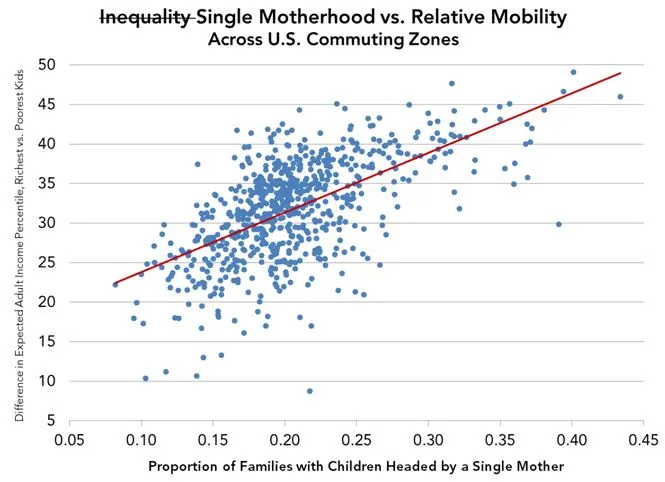The debate rages over whether the “Great Gatsby curve“–positing a link between income inequality and intergenerational mobility–is as fictional as its namesake. The latest salvo is from Scott Winship, over at the Manhattan Institute, throwing buckets of cold water on the theory.
It is an interesting argument for wonks. But in the end it matters little for policy. We can get on with tackling social immobility and/or income inequality without waiting for the outcome of the scholarly spat over statistical connections.
Winship v. Gatsby
Winship and co-author Donald Schneider, from Heritage, use the superb dataset provided by Raj Chetty at his team at Harvard on Census Zones across the U.S. to make three main points:
- Rates of single parenthood predict relative social mobility (correlation = 0.61) better than any of the measures of inequality:

It is a striking graph, and makes the point well. Winship doesn’t think single parenthood causally influences mobility: he is just setting up a straw man that liberals will find discomforting, in order to highlight what he sees as the straw man of the Gatsby curve.
- The Gatsby association is not strong, even when it can be found. The association between inequality of income and mobility is quite weak (0.25 correlation) for one inequality measure (the 25th to 75th percentile gap), and non-existent for another (the share of income taken by the top 1%).
- Focusing on the big metro areas removes the Gatsby association. By narrowing his analysis to the biggest 100 CZs–accounting for 70% of the U.S. population–Winship removes the Gatsby association altogether.
So What?
It is clear this one will run and run. Miles Corak, for sure, will want to answer the Winship challenge. A few quick points for now:
- There is a modest association between income inequality and immobility, using some measures, some of the time–though Winship casts useful doubt on this. Nobody has ever, to my knowledge, found a relationship in the other direction.
- Correlation does not equal causation. There are bound to be a number of political, institutional, and cultural factors acting on both of these factors.
- There is nothing to suggest that reducing inequality will automatically improve rates of mobility.
- Inequality and social mobility do not need to be causally connected in order to care about each of them. Some will care more about income inequality, others more about immobility: in the end, that’s a question of political philosophy.
- The combination of inequality and low social mobility is toxic regardless of any statistical link between them. High inequality might be tolerable with plenty of movement between rich and poor. Lower mobility might be tolerable with more redistribution to narrow the income gap. Nobody, whatever their political persuasion, can tolerate both.
- The questions about the Gatsby curve are interesting. But policy does not have to wait on the answers.


Commentary
Social Mobility, Inequality, and Why the Great Gatsby Curve Doesn’t Matter, Really
December 31, 2013